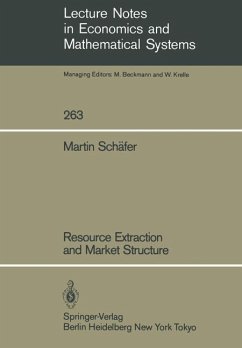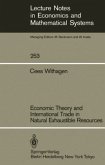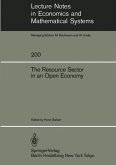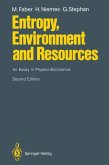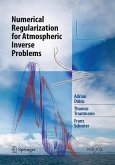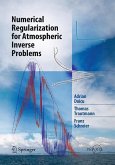Martin Schäfer
Resource Extraction and Market Structure
Martin Schäfer
Resource Extraction and Market Structure
- Broschiertes Buch
Andere Kunden interessierten sich auch für
![Economic Theory and International Trade in Natural Exhaustible Resources Economic Theory and International Trade in Natural Exhaustible Resources]() Cees WithagenEconomic Theory and International Trade in Natural Exhaustible Resources41,99 €
Cees WithagenEconomic Theory and International Trade in Natural Exhaustible Resources41,99 €![The Resource Sector in an Open Economy The Resource Sector in an Open Economy]() The Resource Sector in an Open Economy81,99 €
The Resource Sector in an Open Economy81,99 €![Entropy, Environment and Resources Entropy, Environment and Resources]() Horst NiemesEntropy, Environment and Resources40,99 €
Horst NiemesEntropy, Environment and Resources40,99 €![Numerical Regularization for Atmospheric Inverse Problems Numerical Regularization for Atmospheric Inverse Problems]() Adrian DoicuNumerical Regularization for Atmospheric Inverse Problems154,99 €
Adrian DoicuNumerical Regularization for Atmospheric Inverse Problems154,99 €![Numerical Regularization for Atmospheric Inverse Problems Numerical Regularization for Atmospheric Inverse Problems]() Adrian DoicuNumerical Regularization for Atmospheric Inverse Problems154,99 €
Adrian DoicuNumerical Regularization for Atmospheric Inverse Problems154,99 €![Global Environmental Change Global Environmental Change]() Kirill Y. KondratyevGlobal Environmental Change161,99 €
Kirill Y. KondratyevGlobal Environmental Change161,99 €![Bioökonomie für Einsteiger Bioökonomie für Einsteiger]() Bioökonomie für Einsteiger39,99 €
Bioökonomie für Einsteiger39,99 €-
-
-
Produktdetails
- Lecture Notes in Economics and Mathematical Systems 263
- Verlag: Springer / Springer Berlin Heidelberg / Springer, Berlin
- Artikelnr. des Verlages: 978-3-540-16081-6
- 1986.
- Seitenzahl: 172
- Erscheinungstermin: 1. Februar 1986
- Englisch
- Abmessung: 244mm x 170mm x 10mm
- Gewicht: 280g
- ISBN-13: 9783540160816
- ISBN-10: 3540160817
- Artikelnr.: 26717113
Hinweis: Dieser Artikel kann nur an eine deutsche Lieferadresse ausgeliefert werden.
- Herstellerkennzeichnung Die Herstellerinformationen sind derzeit nicht verfügbar.
I Dynamic Models of Resource Extraction in Markets of Monopoly or Pure Competition with Full Information.- 1. Hotelling's Model.- 2. Optimal Extraction Rates and Exploration.- 2.1 Pure Competition.- 2.2 Monopoly.- 3. Optimal Extraction Rates and Constant Elasticity of Demand.- 4. Market Structure and Optimal Depletion Rates.- 4.1 Pure Competition.- 4.2 Monopoly.- 5. Extraction of an Exhaustible Resource and Production of a Substitute.- 5.1 Social Optimum.- 5.2 Extraction of the Resource and Production of the Substitute by the same Monopoly.- 5.3 Many Owners of the Resource and Production of the Substitute by Monopoly.- 5.4 Many Owners of the Resource and Production of the Substitute by all.- 6. Extraction of Durable Exhaustible Resources.- 6.1 Discrete Time.- 6.2 Continuous Time.- 6.2.1 Pure Competition.- 6.2.2 Monopoly.- 7. Conclusions.- II Dynamic Models with Uncertainty and Monopolistic Markets or Pure Competition.- 1. Optimal Extraction Rates and Uncertainty with Respect to R&D towards Future Technologies.- 1.1 Exogenous Technical Progress.- 1.1.1 Basic Model.- 1.1.2 First Extension: Production.- 1.1.3 Second Extension: Exhaustible Resources.- 1.1.4 Third Extension: Uncertainty about the Future Technological Development.- 1.2 Endogenous Technical Progress.- 1.2.1 Basic Model.- 1.2.2 Modification of the Basic Model.- 1.2.3 Example with Exponentially Distributed Z.- 2. Optimal Extraction Rates and Unknown Reserves.- 2.1 Monopolistic Extraction Rates Depending on Time only.- 2.2 Monopolistic Extraction Rates Depending on Time and Quantities already Extracted.- 2.3 Optimal Extraction Rates and Pure Competition.- 2.3.1 Basic Model.- 2.3.2 Example with Two Suppliers.- 2.4 Optimal Extraction Rates from Consumer's View.- 2.4.1 Basic Model.- 2.4.2 Example withExponentially Distributed Z.- 2.5 Pure Competition and Optimal Extraction.- 3. Optimal Extraction Rates and Unknown Costs of the Development of a Substitute.- 3.1 One-period Analysis and Monopoly.- 3.2 One-period Analysis and Pure Competition.- 3.3 Two-period Analysis.- 3.3.1 Optimal Extraction and One Decision Maker.- 3.3.1.1 Basic Model.- 3.3.1.2 Example with Linear Demand.- 3.3.2 Optimal Extraction and Pure Competition.- 3.3.3 Extraction of the Resource and Production of the Substitute by Exactly One Monopoly.- 4. Conclusions.- III Short Introduction to the Theory of Differential Games.- IV Dynamic Models of Resource Extraction and Duopolistic Markets.- 1. An Introductory Duopoly Model with Production Strategies.- 2. Duopoly with Price Strategies and Exploration.- 2.1 Open-loop Controls.- 2.2 Closed-loop Controls.- 3. A Duopoly Model with Quantity Strategies.- 3.1 Introduction of the Model.- 3.2 Specialization of the Model: Linear-Quadratic Differential Game.- 4. Cartelization and Optimal Extraction of Exhaustible Resources.- 4.1 Pure Competition.- 4.2 Monopolistic Behaviour of the Cartel.- 4.3 Implications of Cartelization to the Profits of the Non-Cartel.- 5. Oligopoly with Discrete Time Parameter.- 6. Conclusions.- V Oligopolistic Extraction with Continuous Time.- 1. Basic Model with Quantity Strategies.- 1.1 Introduction of the Model.- 1.2 Algorithm for the Determination of a Nash Equilibrium.- 2. Specializations of the Basic Model.- 2.1 Fixed Resource Stock.- 2.2 Deterministic Expandable Resource Stocks.- 3. Oligopoly and Price Strategies.- 4. Conclusions.
I Dynamic Models of Resource Extraction in Markets of Monopoly or Pure Competition with Full Information.- 1. Hotelling's Model.- 2. Optimal Extraction Rates and Exploration.- 2.1 Pure Competition.- 2.2 Monopoly.- 3. Optimal Extraction Rates and Constant Elasticity of Demand.- 4. Market Structure and Optimal Depletion Rates.- 4.1 Pure Competition.- 4.2 Monopoly.- 5. Extraction of an Exhaustible Resource and Production of a Substitute.- 5.1 Social Optimum.- 5.2 Extraction of the Resource and Production of the Substitute by the same Monopoly.- 5.3 Many Owners of the Resource and Production of the Substitute by Monopoly.- 5.4 Many Owners of the Resource and Production of the Substitute by all.- 6. Extraction of Durable Exhaustible Resources.- 6.1 Discrete Time.- 6.2 Continuous Time.- 6.2.1 Pure Competition.- 6.2.2 Monopoly.- 7. Conclusions.- II Dynamic Models with Uncertainty and Monopolistic Markets or Pure Competition.- 1. Optimal Extraction Rates and Uncertainty with Respect to R&D towards Future Technologies.- 1.1 Exogenous Technical Progress.- 1.1.1 Basic Model.- 1.1.2 First Extension: Production.- 1.1.3 Second Extension: Exhaustible Resources.- 1.1.4 Third Extension: Uncertainty about the Future Technological Development.- 1.2 Endogenous Technical Progress.- 1.2.1 Basic Model.- 1.2.2 Modification of the Basic Model.- 1.2.3 Example with Exponentially Distributed Z.- 2. Optimal Extraction Rates and Unknown Reserves.- 2.1 Monopolistic Extraction Rates Depending on Time only.- 2.2 Monopolistic Extraction Rates Depending on Time and Quantities already Extracted.- 2.3 Optimal Extraction Rates and Pure Competition.- 2.3.1 Basic Model.- 2.3.2 Example with Two Suppliers.- 2.4 Optimal Extraction Rates from Consumer's View.- 2.4.1 Basic Model.- 2.4.2 Example withExponentially Distributed Z.- 2.5 Pure Competition and Optimal Extraction.- 3. Optimal Extraction Rates and Unknown Costs of the Development of a Substitute.- 3.1 One-period Analysis and Monopoly.- 3.2 One-period Analysis and Pure Competition.- 3.3 Two-period Analysis.- 3.3.1 Optimal Extraction and One Decision Maker.- 3.3.1.1 Basic Model.- 3.3.1.2 Example with Linear Demand.- 3.3.2 Optimal Extraction and Pure Competition.- 3.3.3 Extraction of the Resource and Production of the Substitute by Exactly One Monopoly.- 4. Conclusions.- III Short Introduction to the Theory of Differential Games.- IV Dynamic Models of Resource Extraction and Duopolistic Markets.- 1. An Introductory Duopoly Model with Production Strategies.- 2. Duopoly with Price Strategies and Exploration.- 2.1 Open-loop Controls.- 2.2 Closed-loop Controls.- 3. A Duopoly Model with Quantity Strategies.- 3.1 Introduction of the Model.- 3.2 Specialization of the Model: Linear-Quadratic Differential Game.- 4. Cartelization and Optimal Extraction of Exhaustible Resources.- 4.1 Pure Competition.- 4.2 Monopolistic Behaviour of the Cartel.- 4.3 Implications of Cartelization to the Profits of the Non-Cartel.- 5. Oligopoly with Discrete Time Parameter.- 6. Conclusions.- V Oligopolistic Extraction with Continuous Time.- 1. Basic Model with Quantity Strategies.- 1.1 Introduction of the Model.- 1.2 Algorithm for the Determination of a Nash Equilibrium.- 2. Specializations of the Basic Model.- 2.1 Fixed Resource Stock.- 2.2 Deterministic Expandable Resource Stocks.- 3. Oligopoly and Price Strategies.- 4. Conclusions.

